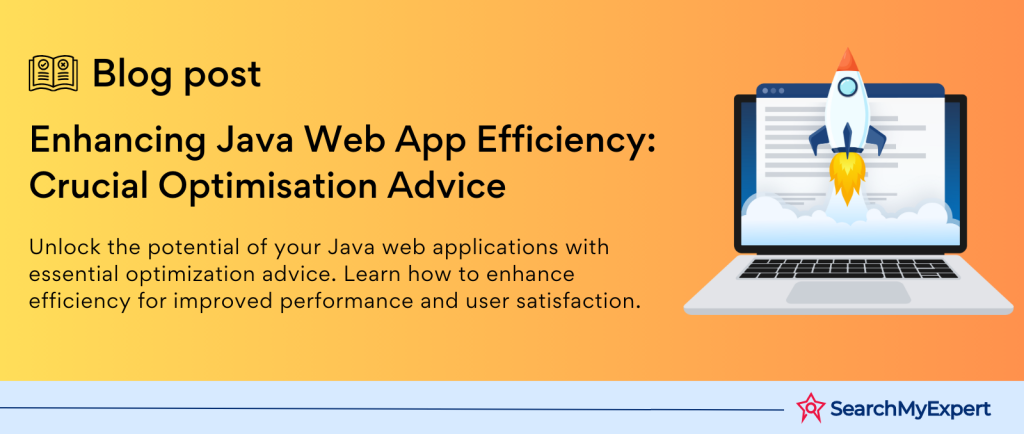Enhancing Performance in Java Web Applications
Defining Performance in Java Web Applications
Performance in Java web applications is a multifaceted concept. It’s the speed and efficiency with which these applications run and respond to user interactions. Imagine a smooth, seamless user experience – that’s the goal!
The Critical Importance of Optimal Performance
- User Experience (UX):
Superb performance equals happy users. Fast-loading pages and snappy responses keep users engaged and satisfied. - Business Goals:
Speed is money! Swift applications lead to higher conversion rates, better customer retention, and a competitive edge. - Resource Utilization:
Efficient applications use server and network resources wisely, reducing costs and enhancing scalability.
Areas of Performance Optimization
- Backend Efficiency:
It’s all about how Java handles data operations, algorithms, and server-side scripting. - Frontend Dynamics:
The user’s playground. Optimizing JavaScript, CSS, and HTML for faster rendering and interaction. - Database Interaction:
Swift and efficient data fetching and writing. Think of it as a well-organized digital library. - Network Utilization:
Reducing the data travel time between the server and the client. - Memory Management: Java’s forte! Efficient use of memory ensures smooth operations and scalability.
- Concurrency Handling: Java web applications must handle multiple users and processes elegantly and efficiently.
Understanding Bottlenecks and Metrics
Identifying Common Performance Bottlenecks
In Java web applications, bottlenecks are like roadblocks slowing down your journey. Let’s spotlight a few:
- Database Queries: Slow queries are time thieves! They delay data retrieval and can grind your app to a halt.
- JVM Configuration:
If JVM (Java Virtual Machine) isn’t tuned right, it’s like running a sports car on
low-grade fuel. - Network Latency: The time data takes to travel. High latency is like a long, winding road delaying the journey.
- Resource Contention: When multiple processes fight over resources. Imagine a traffic jam in your application!
- Garbage Collection: Necessary but can be disruptive. It’s like taking frequent pit stops in a race.
Key Performance Metrics to Track
- Response Times: How long does it take to respond to user requests? Speed is key!
- Resource Utilization: How much CPU and memory are you using? Efficiency is crucial.
- Throughput:
The number of requests handled per unit of time. Think of it as your app’s horsepower. - Error Rates: How often do things go wrong? Low error rates mean a smoother ride.
- User Satisfaction:
Ultimately, it’s about how happy your users are. Happy users, successful app!
The Importance of Performance Baselines and Trends
Establishing baselines is like having a roadmap. You know where you started and can track your journey. By monitoring trends over time, you can spot when performance dips and take action. It’s about staying ahead of the game, ensuring your Java web application runs like a well-oiled machine.
Optimizing the Application Code
Analyzing Code for Efficiency
- Spot the Drains: Look for resource-hungry operations. It’s like finding which appliance is hiking up your electricity bill.
- Memory Leaks:
They silently bloat your application, like a slow faucet leak filling a bucket.
Refactoring for Performance
- Upgrade Your Algorithms:
Opt for quicker, more efficient routes. Think of it as choosing a high-speed train over a slow bus. - Data Structures Matter: Pick the right tool for the job. It’s like using a sports car for racing and a truck for hauling.
Caching: The Speed Booster
- Reduce Database Calls:
Keep frequently accessed data handy. It’s like keeping your tools on the top shelf, not in the basement. - Faster Page Loads: Store parts of web pages for quick access. Imagine having your favorite snacks at arm’s length.
Best Practices for Object Creation and Garbage Collection
- Smart Object Creation:
Create only what you need. It’s like cooking the right amount of food – no waste. - Efficient Garbage Collection: Keep your memory clean without overhead. Think of it as regular, unobtrusive housekeeping.
Adopting these strategies transforms your Java web application into a lean, mean, performance machine!
Fine-tuning JVM Configuration
Understanding JVM Memory Management
- The Memory Maestro:
JVM manages how your app uses memory. It’s like a conductor leading an orchestra, ensuring harmony. - Heap Space:
The heart of memory management. Getting it right is like balancing your diet – not too little, not too much.
Configuring for Peak Performance
- Heap Sizes:
Tailor them to your app’s needs. It’s like custom-fitting a suit for the perfect look. - Garbage Collection Algorithms: Choose wisely. Each algorithm is a different strategy in the game of memory management.
Tools for Monitoring and Analysis
- JVisualVM:
The looking glass into JVM’s world. Understand what’s happening under the hood. - GC Logs:
These logs are your breadcrumbs. Follow them to see how memory is being managed and reclaimed.
Fine-tuning JVM is like setting up your car for a race. Get it right, and you’re on the track to peak performance!
Database Optimization Strategies
Turbocharging Database Queries
- Minimize Execution Time: Trim down query lengths. It’s like taking shortcuts instead of the scenic route.
- Reduce Resource Consumption: Use resources smartly. Imagine running your home appliances only when needed.
Crafting an Efficient Database Schema
- Strategic Design:
It’s like architecting a building for easy navigation. Every room (table) is placed logically. - Indexing:
The secret sauce for quick data retrieval. Think of it as a well-organized book index.
Connection Pooling and Caching: The Efficiency Duo
- Connection Pooling:
Reuse database connections. It’s like carpooling; more efficient and environmentally friendly. - Caching Mechanisms: Store frequently accessed data. It’s like keeping your favorite book by your bedside.
Implement these strategies, and watch your database turn into a high-performance engine!
Leveraging Caching and Content Delivery Networks (CDNs)
Implementing Caching for Static Content
- Why Caching? It’s like having a mini-store in every neighborhood – faster access, less travel!
- What to Cache? Images, CSS, JavaScript. These are your basics, like bread, milk, and eggs in the store.
- Impact: Reduces server load, like fewer shoppers in the main store. Improves page load times – quick and easy access!
Utilizing CDNs for Global Reach
- CDN Magic:
Distribute content across the globe. It’s like having multiple stores in different cities. - Minimize Latency:
Faster delivery for users everywhere. It’s like getting pizza delivered hot and fresh, no matter where you are.
By leveraging caching and CDNs, you’re not just optimizing; you’re revolutionizing user experience!
Continuous Monitoring and Performance Improvement
Implementing Automated Monitoring Tools
- Always Be Watching: Like having CCTV for your app. Catch issues before they become problems.
- Track Key Metrics:
Keep an eye on response times, resource utilization, and more. It’s like monitoring vital signs.
Establishing a Continuous Improvement Process
- Regular Check-ups: Periodic performance assessments. Think of it as regular health check-ups for your application.
- Feedback Loops: Learn and adapt. It’s like evolving based on customer feedback and experience.
Staying Ahead with Technology and Techniques
- Keep Learning:
New technologies emerge. Stay curious, stay relevant. - Optimize Continuously: What works today may not tomorrow. Keep tuning, keep refining.
Embrace these practices, and you’ll ensure your Java web application is not just running, but soaring!
Conclusion
To wrap it up, enhancing performance in Java web applications is a continuous journey, not a one-time fix. By identifying bottlenecks, optimizing code, fine-tuning JVM, streamlining databases, leveraging caching and CDNs, and embracing continuous monitoring, you ensure your application stays fast, efficient, and ahead of the curve. Remember, the key is to adapt, evolve, and keep pace with emerging technologies and methods. This approach guarantees not just a high-performing application but also a delightful user experience, ultimately contributing to the success of your business.
Guide your software strategy with our Java Development Service Company.
Table of Contents
Toggle






